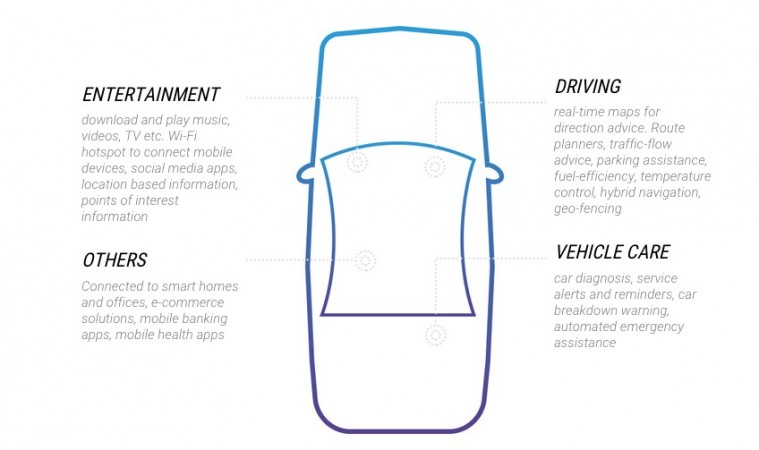5 ways connected cars are accentuating driving experience
A car company recently came up with an advertisement where you can see people sync their mobiles to car and instruct it verbally to play songs, show maps, etc. Last year Google unveiled its driverless car. All these advancements are the giant steps into the future of automobile industry; connected cars, where you can remain connected to the world even on wheels and also control all the devices inside your car without risking safety. The basic concept behind connected cars is transforming the vehicle into a node in ‘www’ universe.
IoT enables connected cars to create an entirely new ecosystem of connected services. The car turns into a hub providing customers a lot many advantages and better experience while driving, in the form of enhanced security and safety, and new suite of product offerings.
5 ways in which connected cars technology is accentuating driving experience:
- 1. Mobile Hotspot: In-vehicle hotspot capabilities is the new thing car manufacturers have introduced for customers’ convenience. Using this, now drivers as well as passengers can remain connected even inside the car. Leveraging IoT, connectivity is being provided for all kinds of mobile devices.
- 2. Infotainment: So far, people used to make calls and navigate on cars via bluetooth only but streaming apps was never an option. Using the IoT platform, car manufacturers are providing connectivity in cars, where you can easily stream contents, have free trials of services being provided by manufacturers and retailers.
- 3. Safety and security: The most important aspect for automobile manufacturers is ensuring safety and security of customers. So, while providing connectivity in cars, focus is on making the drive more secure. Many steps have been taken for it like introducing threat alert which alerts the risk of accident if it is anywhere in its range, black box (records the details of accident a few seconds before and after accident so that reason can be known), crash notification (sends accident alert automatically), emergency assistance, etc. These features have low-latency in connectivity and are thus reliable and life saving because even a slightest delay can cause huge loss.
- 4. Entertainment: The infotainment unit can be synced with phone and it can be used as an entertainment device for downloading music and streaming content. Messages can be received on the screen of the infotainment unit keeping the driver socially active at all times without the need of touching the phone every time.
- 5. New product offering: Connected cars are embedded with mobile broadband chips and they generate vast amounts of data. These data are being used by service providers to make offerings based on the usage patterns. Based on conclusions drawn from these data, insurance companies can decide what type of insurance to offer, manufacturers can measure real-time on-road experience of customers and improve product quality.
As IoT and other enabling technologies evolve, we will see a lot many improvements in connected cars resulting in further accentuating the driving experience.
Tags: Connected Cars
![Blog-[x]cube LABS](https://d6fiz9tmzg8gn.cloudfront.net/wp-content/uploads/2016/06/blog_banner.jpg)


